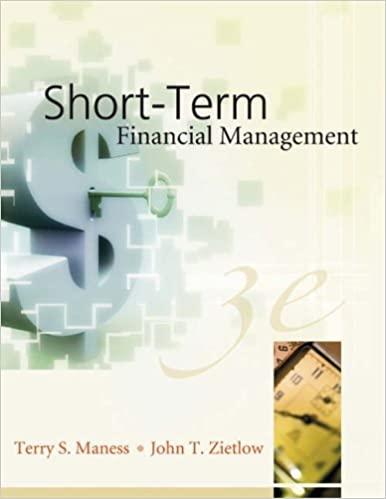Question
Quantitative Problem 1: You deposit $2,500 into an account that pays 6% per year. Your plan is to withdraw this amount at the end of
Quantitative Problem 1: You deposit $2,500 into an account that pays 6% per year. Your plan is to withdraw this amount at the end of 5 years to use for a down payment on a new car. How much will you be able to withdraw at the end of 5 years? Do not round intermediate calculations. Round your answer to the nearest cent.
$
Quantitative Problem 2: Today, you invest a lump sum amount in an equity fund that provides an 11% annual return. You would like to have $10,900 in 6 years to help with a down payment for a home. How much do you need to deposit today to reach your $10,900 goal? Do not round intermediate calculations. Round your answer to the nearest cent.
$
e can solve for payments (PMT), periods (N), and interest rates (I) for annuities. The easiest way to solve for these variables is with a financial calculator or a spreadsheet.
Quantitative Problem 1: You plan to deposit $2,300 per year for 6 years into a money market account with an annual return of 3%. You plan to make your first deposit one year from today.
- What amount will be in your account at the end of 6 years? Do not round intermediate calculations. Round your answer to the nearest cent.
$
- Assume that your deposits will begin today. What amount will be in your account after 6 years? Do not round intermediate calculations. Round your answer to the nearest cent.
$
Quantitative Problem 2: You and your wife are making plans for retirement. You plan on living 25 years after you retire and would like to have $100,000 annually on which to live. Your first withdrawal will be made one year after you retire and you anticipate that your retirement account will earn 10% annually.
- What amount do you need in your retirement account the day you retire? Do not round intermediate calculations. Round your answer to the nearest cent.
$
- Assume that your first withdrawal will be made the day you retire. Under this assumption, what amount do you now need in your retirement account the day you retire? Do not round intermediate calculations. Round your answer to the nearest cent.
$
Quantitative Problem: You own a security with the cash flows shown below.
| 0 | 1 | 2 | 3 | 4 |
| 0 | 620 | 385 | 250 | 290 |
If you require an annual return of 10%, what is the present value of this cash flow stream? Do not round intermediate calculations. Round your answer to the nearest cent.
$
Quantitative Problem: You need $17,000 to purchase a used car. Your wealthy uncle is willing to lend you the money as an amortized loan. He would like you to make annual payments for 6 years, with the first payment to be made one year from today. He requires a 7% annual return.
- What will be your annual loan payments? Do not round intermediate calculations. Round your answer to the nearest cent.
$
- How much of your first payment will be applied to interest and to principal repayment? Do not round intermediate calculations. Round your answers to the nearest cent.
Interest: $
Principal repayment: $
Step by Step Solution
There are 3 Steps involved in it
Step: 1

Get Instant Access to Expert-Tailored Solutions
See step-by-step solutions with expert insights and AI powered tools for academic success
Step: 2

Step: 3

Ace Your Homework with AI
Get the answers you need in no time with our AI-driven, step-by-step assistance
Get Started


